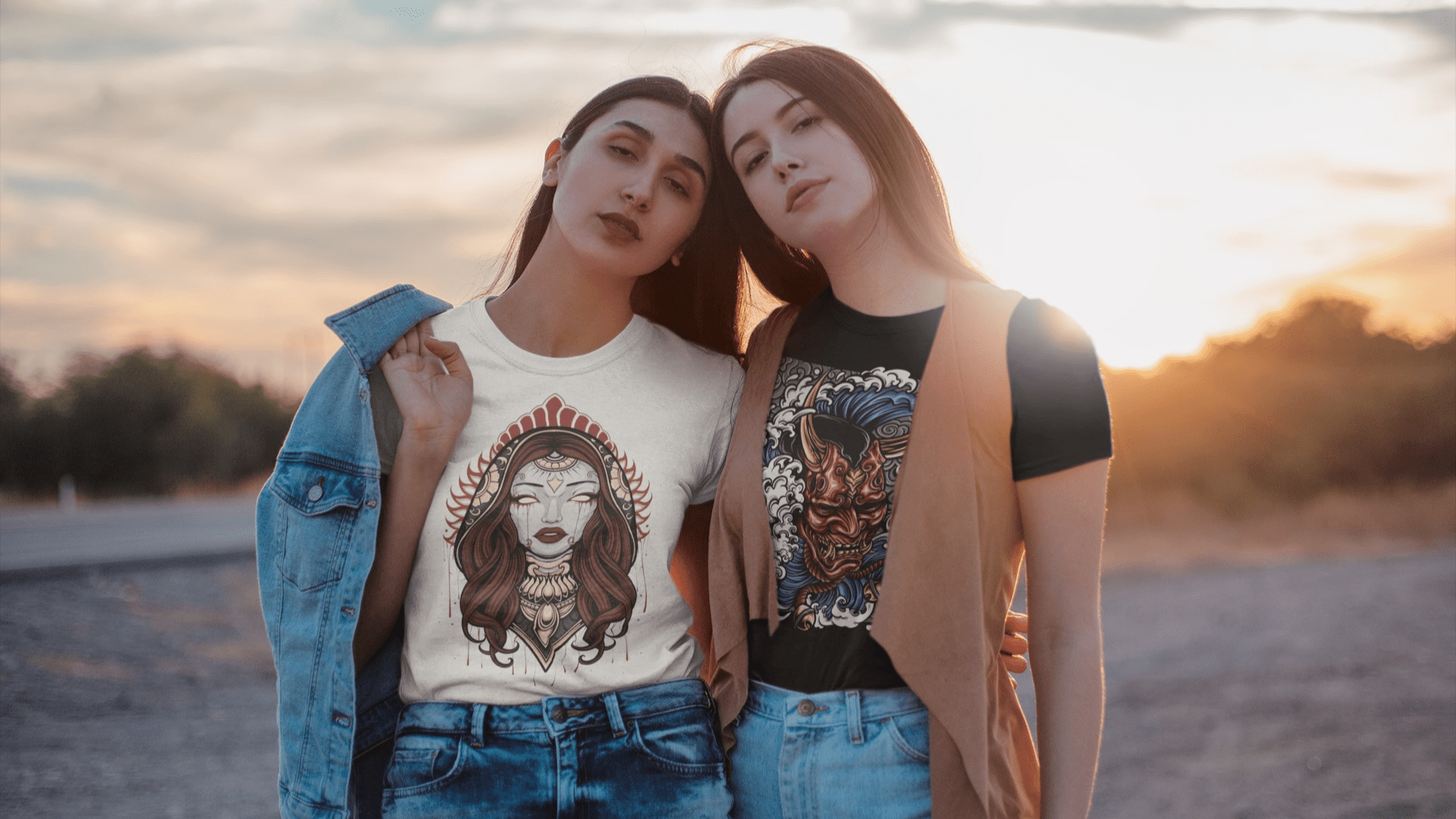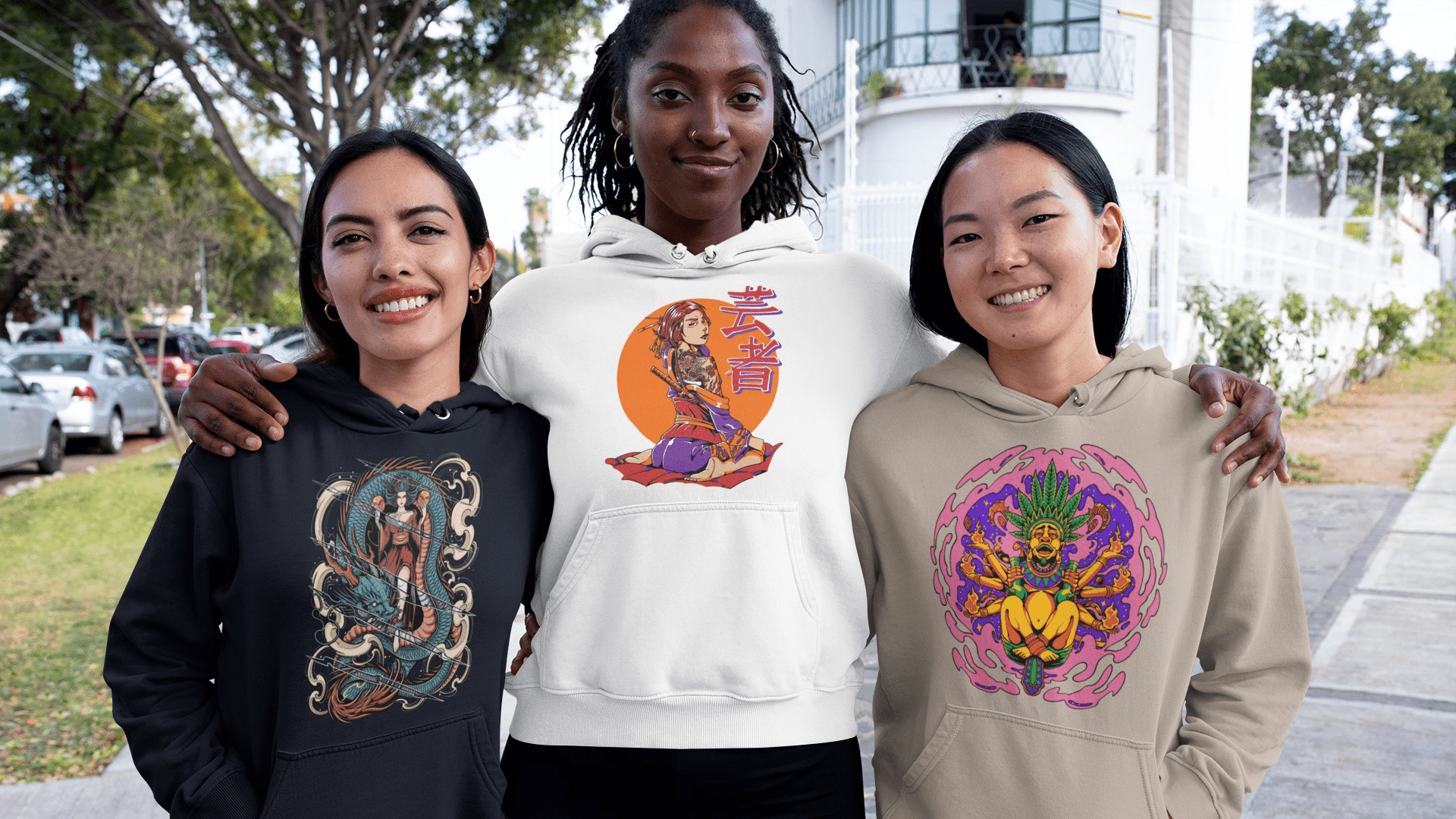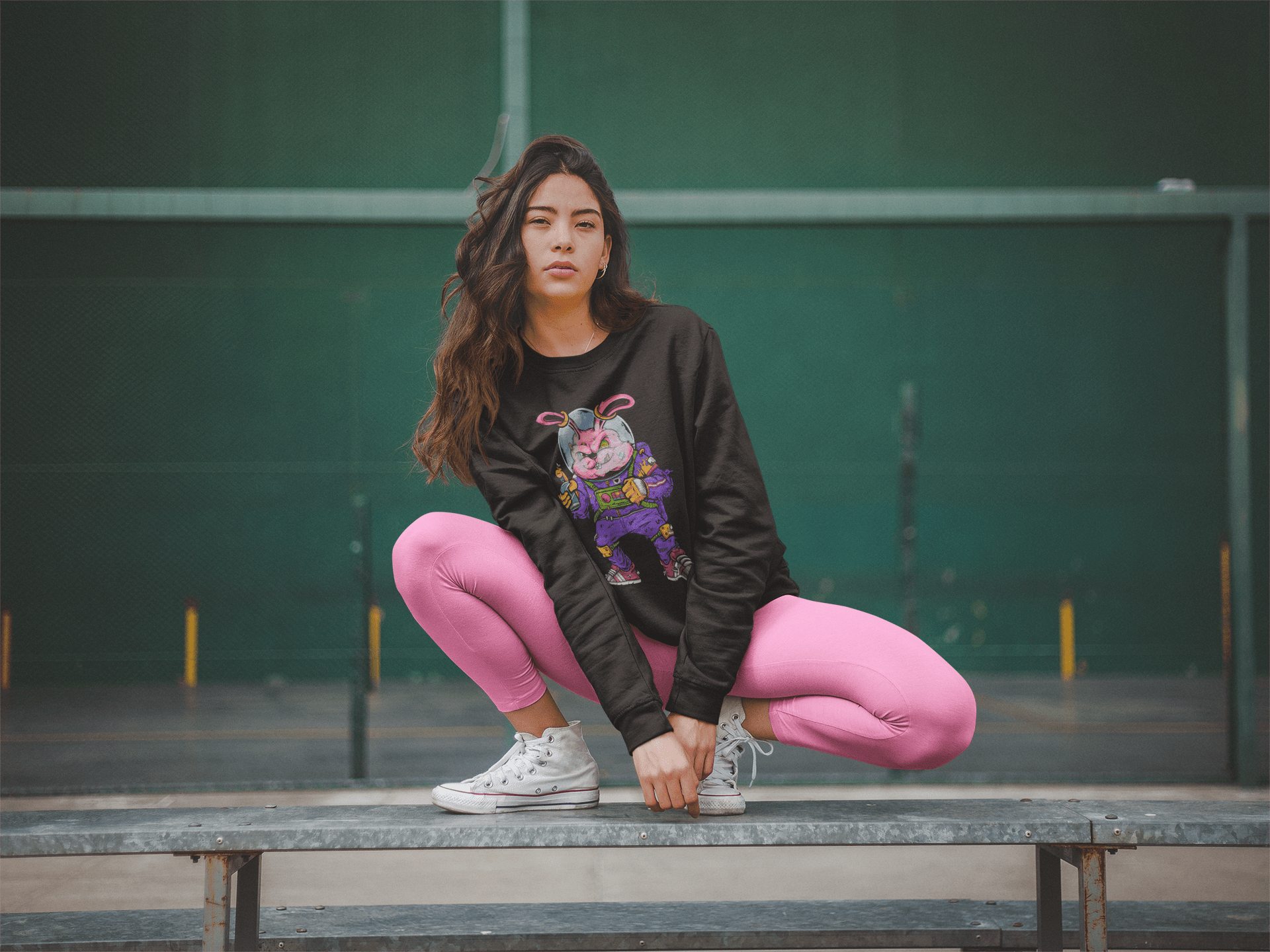Koi Fish 1 - Unisex Hoodie || TeeStitch Apparel
- Regular price
- $95.00
- Sale price
- $95.00
- Regular price
Premium Fabric weight: 10.32 oz./yd.² (350 g/m²) Why This Matters.
Understanding the materials used in your garments can help you appreciate the quality and sustainability behind every piece. Here’s a detailed breakdown of what makes our fabric stand out:
3-End Fleece
This refers to the construction of the fabric. "3-end" fleece means the fabric is made using three separate yarns that create a thicker, more durable, and higher-quality material compared to 2-end fleece. It’s often used for premium sweatshirts or hoodies because of its softness and ability to hold shape.
Cotton Face (Skin): 100% Organic Cotton
The face of the fabric (the outermost surface you touch and see) is made entirely of organic cotton. This gives the fabric a soft, natural feel while maintaining eco-friendliness.
Shell (Body): Brushed, 80% Organic Cotton, 20% Recycled Polyester
Shell refers to the primary material of the garment. The fabric's inner surface has been "brushed" to create a fleece-like feel, making it super soft and cozy against the skin.
1. 80% Cotton - Organic Ring Spun Combed - sustainably sourced and chemical-free.
- Ring Spun: The cotton fibers were twisted to create a finer, smoother, and stronger yarn.
- Combed: The cotton was combed to remove impurities and shorter fibers, making it even softer and more durable.
2. 20% Polyester - Recycled
- The remaining 20% of the fabric is recycled polyester, often made from repurposed plastic bottles or other waste. This addition provides durability, wrinkle resistance, and shape retention, making the garment last longer while staying eco-friendly.
What About Recycled Polyester?
We know that polyester—recycled or not—comes with its challenges, like microplastic shedding during washes. While using recycled polyester helps reduce plastic waste and gives discarded materials a second life, it’s not a perfect solution. That’s why we encourage mindful washing habits, such as using a microplastic filter or washing on a gentle cycle to minimize shedding.
Additionally, some people may have sensitivities or allergies to polyester. While our garments have an organic cotton face, meaning the outermost layer is 100% organic cotton for a soft and natural feel, the fabric still contains a recycled polyester blend for durability. If you have a known polyester allergy, we recommend checking the fabric composition carefully before purchasing.
Our goal is to balance sustainability, durability, and comfort. By incorporating recycled polyester instead of virgin plastic-based fibers, we reduce the demand for new petroleum-based materials while ensuring our garments last longer—so you can buy less and wear more.
Sustainability is a journey, and we’re always looking for better alternatives. We’re making strides toward a more eco-friendly future by choosing high-quality, responsibly sourced fabrics—one piece at a time.
Want to learn more about the fabric, construction, and design details? Check out our Apparel Lingo 101 page for a deeper dive into the terms and features that make our garments stand out.
Understanding the materials used in your garments can help you appreciate the quality and sustainability behind every piece. Here’s a detailed breakdown of what makes our fabric stand out:
3-End Fleece
This refers to the construction of the fabric. "3-end" fleece means the fabric is made using three separate yarns that create a thicker, more durable, and higher-quality material compared to 2-end fleece. It’s often used for premium sweatshirts or hoodies because of its softness and ability to hold shape.
Cotton Face (Skin): 100% Organic Cotton
The face of the fabric (the outermost surface you touch and see) is made entirely of organic cotton. This gives the fabric a soft, natural feel while maintaining eco-friendliness.
Shell (Body): Brushed, 80% Organic Cotton, 20% Recycled Polyester
Shell refers to the primary material of the garment. The fabric's inner surface has been "brushed" to create a fleece-like feel, making it super soft and cozy against the skin.
1. 80% Cotton - Organic Ring Spun Combed - sustainably sourced and chemical-free.
- Ring Spun: The cotton fibers were twisted to create a finer, smoother, and stronger yarn.
- Combed: The cotton was combed to remove impurities and shorter fibers, making it even softer and more durable.
2. 20% Polyester - Recycled
- The remaining 20% of the fabric is recycled polyester, often made from repurposed plastic bottles or other waste. This addition provides durability, wrinkle resistance, and shape retention, making the garment last longer while staying eco-friendly.
What About Recycled Polyester?
We know that polyester—recycled or not—comes with its challenges, like microplastic shedding during washes. While using recycled polyester helps reduce plastic waste and gives discarded materials a second life, it’s not a perfect solution. That’s why we encourage mindful washing habits, such as using a microplastic filter or washing on a gentle cycle to minimize shedding.
Additionally, some people may have sensitivities or allergies to polyester. While our garments have an organic cotton face, meaning the outermost layer is 100% organic cotton for a soft and natural feel, the fabric still contains a recycled polyester blend for durability. If you have a known polyester allergy, we recommend checking the fabric composition carefully before purchasing.
Our goal is to balance sustainability, durability, and comfort. By incorporating recycled polyester instead of virgin plastic-based fibers, we reduce the demand for new petroleum-based materials while ensuring our garments last longer—so you can buy less and wear more.
Sustainability is a journey, and we’re always looking for better alternatives. We’re making strides toward a more eco-friendly future by choosing high-quality, responsibly sourced fabrics—one piece at a time.
Want to learn more about the fabric, construction, and design details? Check out our Apparel Lingo 101 page for a deeper dive into the terms and features that make our garments stand out.

Regular Fit - Standard length, the fabric easily gives into movement.
If you like a looser fit, we suggest ordering a size up.
How to Measure
If you're not sure what size to order, we suggest you use a garment you own as a reference. The fit is easier to grasp if you can refer to a garment you are already familiar with.
Here are some tips on how to measure for a hoodie:
Find a tape measure. You can find a tape measure at most stores that sell sewing supplies.
Stand up straight and relax. You don't want to pull the tape measure too tight or too loose.
Measure your chest. (A) Place the tape measure around the fullest part of your chest, just under your armpits. Or, measure your existing hoodie about 1inch below the arm pit from one side to the other.
Measure the length. (B) Place the tape measure from the highest point of the shoulder to the very bottom of the hoodie.
Measure the arm length. (C) Place the tape measure from the top seam of the sleeve to the bottom of the sleeve cuff.
Compare your measurements to the size chart. Once you have your measurements, compare them to the size chart of the hoodie you're interested in buying. The size chart will typically list the measurements for the garment, such as the bust, waist, and hip measurements.
Order a size up or down, as needed. If your measurements are between two sizes, it's usually best to order a size up. This will give you a little extra room to move around and layer.
Please make sure you review our return/exchange policy by clicking here.
Please note that our apparel sizes are based on European measurements, which run smaller than US measurements. This means that you may need to order a size larger than you normally wear in US clothing. We suggest comparing our product measurements to something that you already own.
Body Measurement

Product Measurements

How to Measure
If you're not sure what size to order, we suggest you use a garment you own as a reference. The fit is easier to grasp if you can refer to a garment you are already familiar with.
Here are some tips on how to measure for a hoodie:
Find a tape measure. You can find a tape measure at most stores that sell sewing supplies.
Stand up straight and relax. You don't want to pull the tape measure too tight or too loose.
Measure your chest. (A) Place the tape measure around the fullest part of your chest, just under your armpits. Or, measure your existing hoodie about 1inch below the arm pit from one side to the other.
Measure the length. (B) Place the tape measure from the highest point of the shoulder to the very bottom of the hoodie.
Measure the arm length. (C) Place the tape measure from the top seam of the sleeve to the bottom of the sleeve cuff.
Compare your measurements to the size chart. Once you have your measurements, compare them to the size chart of the hoodie you're interested in buying. The size chart will typically list the measurements for the garment, such as the bust, waist, and hip measurements.
Order a size up or down, as needed. If your measurements are between two sizes, it's usually best to order a size up. This will give you a little extra room to move around and layer.
Please make sure you review our return/exchange policy by clicking here.
Please note that our apparel sizes are based on European measurements, which run smaller than US measurements. This means that you may need to order a size larger than you normally wear in US clothing. We suggest comparing our product measurements to something that you already own.
Body Measurement

Product Measurements

Product Information
- 100% organic cotton
- Fabric weight: 10.32 oz./yd.² (350 g/m²)
- Regular fit
- Set-in sleeves
- Self-fabric double-layered hood
- Front pouch pocket
- 1×1 rib at sleeve hem and bottom hem
- Single-needle topstitch at the neckline and along the hood opening
- Metal eyelets
- Inside tape at the back of the neck
- Self-fabric half-moon at the back of the neck
- The fabric of this product is certified by GRS (Global Recycled Standard), OCS (Organic Content Standard), and GOTS (Global Organic Textile Standard)
- The fabric of this product is OEKO-TEX Standard 100 certified and PETA-Approved Vegan
- Blank product sourced from Bangladesh
The sizes correspond to a smaller size in the US market, so US customers should order a size up.
• Traceability:
- Weaving—Bangladesh
- Dyeing—Bangladesh
- Manufacturing—Bangladesh
• Contains 15% recycled polyester
• Contains 0% dangerous substances
Things to know before you order
We value transparency and want to ensure you have all the information you need to make the best choice. Here are a few important things to keep in mind:
- Color Differences:
Please note that colors on the screen may appear slightly different in person due to monitor settings. We ensure high-quality printing, but slight variations in color are normal. - Shipping Times:
Our products are made-to-order and shipped directly from Europe, which can sometimes result in longer shipping times. Most orders arrive within 3-25 business days, depending on the destination and current shipping conditions. - European Sizing:
Our garments are based on European sizes, which may run smaller than standard US sizing. Please refer to our size guide and consider sizing up if you prefer a looser fit. We want to make sure you get the perfect size! - Dark Garment Printing:
On dark-colored garments, designs may appear slightly less vibrant compared to lighter fabrics. We use a white underbase to maintain the best possible quality and color accuracy.
Returns
We have a 30-day return policy, which means any claims for misprinted/damaged/defective items must be submitted within 30 days of receiving your item to request a return. View our complete return/refund policy here.
Care Instructions
We recommend you turn your garment inside out, wash in cold water and hang dry to help keep it from fading, peeling and shrinking. NEVER iron directly on designs.
For more tips on how to care for your clothes and make them last longer, check out our blog: How to Make Your Clothes Last Longer and Reduce Waste.


















